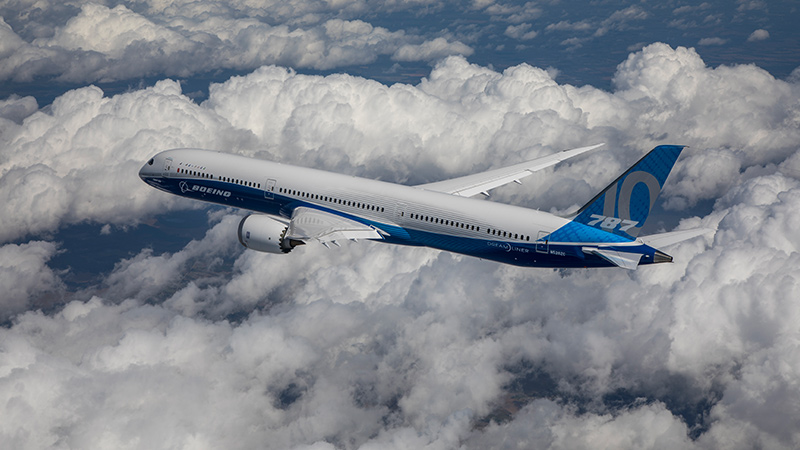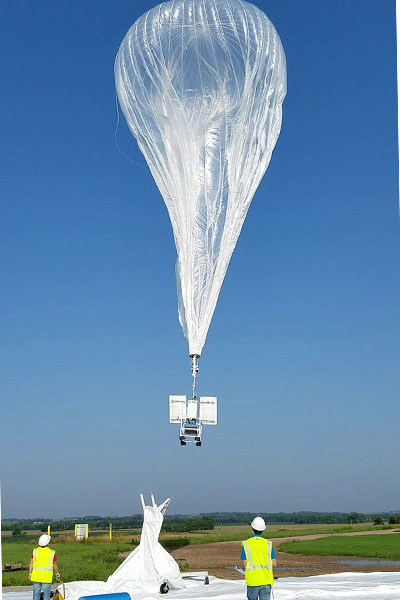Airbus, Boeing airliners make first flights
By Imon Chakraborty, Michael Drake and Matthew Orr|December 2017
The Aircraft Design Technical Committee promotes optimization of aircraft systems, including analysis of their future potential.
It has been an eventful year for the aerospace and aviation industries. In commercial aviation, the Boeing 787-10 had its nearly five-hour first flight out of Boeing’s facility in North Charleston, South Carolina, in March. The newest and longest 787 family member is powered by two General Electric GEnx-1B or Rolls-Royce Trent 1000 TEN engines.
Boeing’s 737 MAX program also had a busy year, with first flight of the CFM Leap 1B-powered MAX 9 in April, followed by first airline delivery of the 737 MAX 8 to Malaysian carrier Malindo Air in May, and launch of its newest and largest variant of the family, the 737 MAX 10, at the Paris Air Show in June. The 737 MAX program, with more than 4000 orders from 93 customers, is the fastest-selling aircraft in the company’s history.
Airbus had notable firsts as well. In April, it delivered the first A321neo, the largest member of the A320 family, to launch customer Virgin America (part of Alaska Air Group). This aircraft, powered by two CFM International Leap-1A or Pratt and Whitney PW1100G turbofans, offers significant fuel burn and noise reductions over previous generation aircraft.
In October, the Airbus A330neo made its first flight at Blagnac in Toulouse, France. An 1,100-hour flight test campaign for the 287-PAX A330-900neo variant is scheduled for FAA and European Aviation Safety Agency type certification in mid-2018. Powered by the latest-generation Rolls-Royce Trent 7000 engines, the aircraft is slated to reduce fuel consumption 14 percent relative to the original A330.
China’s challenger to the Airbus A320 and Boeing 737, the COMAC C919, made its first flight in May 2017. The C919 has 730 orders from 27 different customers. Bombardier Commercial Aircraft delivered its first C-Series CS300 aircraft to airBaltic in December 2016. In May 2017, Swiss International Air received its first CS300 aircraft. The airline became the first to operate both C-Series models and, in August, completed the first C-Series revenue service with a CS100 between Zurich and London City Airport. In 2017, numerous companies presented concepts for on-demand mobility, electric/electric hybrid propulsion and autonomy aircraft, with several flight test demonstrations taking place.
In June, Airbus Helicopters, in collaboration with Helocopteres Guimbal, announced it had begun autonomous flight trials of the VSR700 Optionally Piloted Vehicle demonstrator. The vehicle took off, hovered, performed maneuvers and landed with a human “safety” pilot on board.
In April, the prototype electric-powered vertical takeoff and landing Lilium jet made its first test flights near Munich. While the prototype was remotely piloted, the long-term vision is to launch a piloted five-seater version.
On Sept. 25, German company Volocopter GmbH demonstrated its 18-rotor Volocopter all-electric VTOL autonomous urban flying taxi prototype in Dubai.
In April, Aurora Flight Sciences demonstrated a quarter-scale model of the eVTOL air taxi it’s developing for the Uber Elevate urban air transport network in collaboration with Berlin-based BCG Digital Ventures.
In military aviation, the Boeing/Saab T-X trainer continued its flight test program this year; its first flight was Dec. 20, 2016. The clean-sheet design aims to replace the aging Air Force T-38 Talon aircraft with compatibility with fifth-generation fighters like the F-22 Raptor and F-35 Lightning II aircraft. The advanced cockpit, twin-tailed trainer is powered by a single GE F404 engine. Bell’s V-280 advanced tilt-rotor was slated for first flight before the end of the year. Northrop Grumman subsidiary Scaled Composites flew its Model 401 demonstrator in October.
In aviation research, the Perlan 2, a two-seat, pressurized experimental glider, set a glider world altitude record of just over 52,000 feet in September. In October, Lockheed Martin submitted its proposal for the X-plane for the Quiet Supersonic Transport, or QueSST, low boom demonstrator.
Contributors: Roelof Vos, Bill Crossley, Ruben Perez and Charlie Svoboda Michael Drake and Matthew Orr work for Boeing.



































